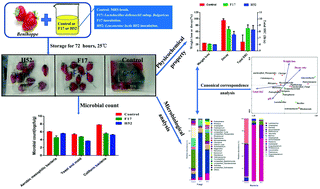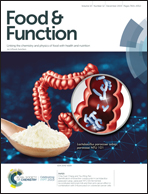Lactobacillus delbrueckii subsp. bulgaricus F17 and Leuconostoc lactis H52 supernatants delay the decay of strawberry fruits: a microbiome perspective†
Abstract
Strawberries are vulnerable to physical injuries and microbial invasion. To explore if beneficial lactic acid bacteria can improve the shelf life and edible quality of postharvest strawberry fruits, the effects of Lactobacillus delbrueckii subsp. bulgaricus (ital.) F17 (F17) and Leuconostoc lactis (ital.) H52 (H52) inoculation on the strawberry microbial community structure and saleable characteristics were examined by bacterial 16S rRNA and fungal ITS sequencing techniques. Lactobacillus (ital.) F17 and Leuconostoc lactis (ital.) H52 isolated from the traditional fermented yak milk in the Qinghai-Tibetan Plateau were used as the potential probiotic inocula. Samples from treated strawberries stored at 25 °C for 0, 12, 24, 48, and 72 hours were analyzed for their pH, weight loss percentage, decay percentage, total soluble solid content (SSC) and microbial counts, and for microbiome community diversity and canonical correspondence analysis. The results showed that F17 and H52 did not only significantly reduce the weight loss and decay percentage of strawberry fruits, but also delayed the decrease of the total SSC and pH (P < 0.05). In addition, F17 and H52 significantly inhibited the growth and colonization of aerobic mesophilic bacteria, yeast, mold and coliform bacteria. In particular, by comparing the microbiota composition of the samples, F17 significantly inhibited Pantoea, Mycospherella, unclassified_Pleosporales, Aureobasidium and Phoma at the genus level, whereas H52 inhibited Bacillus, Streptophyta, Mycospherella, Aureobasidium and Phoma. Moreover, analysis of alpha and beta diversity revealed that F17 and H52 had a significantly greater inhibitory effect on bacterial species compared to fungi. The results of canonical correspondence analysis revealed that the total SSC and pH were positively correlated with bacteria, whereas the decay percentage, weight loss percentage and total SSC were positively associated with fungi. Additionally, Podosphaera, Hanseniaspora, Botrytis and unclassified_Pleosporales were positively correlated with strawberry fruit decay and weight loss percentage. As a general result, Lactobacillus F17 and Leuconostoc lactis H52 have the potential to promote biological preservation, which is economically important to reduce the loss due to strawberry spoilage.



 Please wait while we load your content...
Please wait while we load your content...